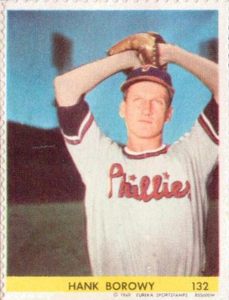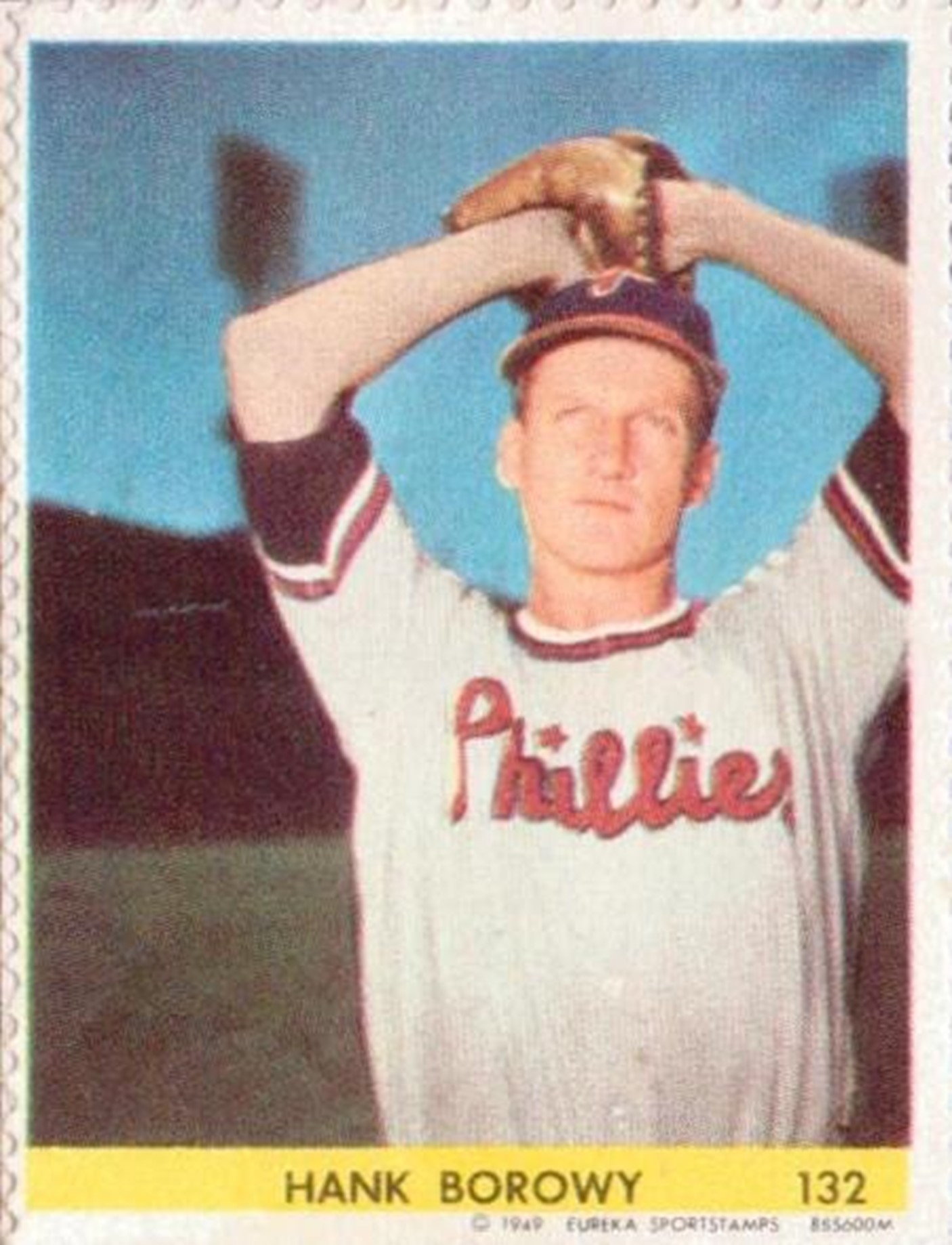June 5, 1949: Foul ball at Phillies-Cubs game leads to precedent-setting lawsuit
 Roses have thorns. Gardens have snakes. And ballparks have foul balls.
Roses have thorns. Gardens have snakes. And ballparks have foul balls.
Foul balls aren’t always the downside of the sport. When they land in a fan’s outstretched hands, or roll into a child’s grasp, everyone shares the vicarious pleasure of the souvenir. But there’s no denying that every foul ball is also a missile – a potential severe injury to the distracted, unwary, or simply slow-to-react. Some players have admitted that they intentionally don’t follow the flight of their foul balls, because they don’t want to know where they land.1
For more than a century, lawsuits have defined and redefined the responsibility of baseball teams to protect their fans, as compared to the fans’ obligation to protect themselves.2 One noteworthy case that established a lasting precedent arose from the first game of an otherwise uneventful doubleheader at Philadelphia’s Shibe Park on June 5, 1949, when the Chicago Cubs faced off against the Philadelphia Phillies.
The doubleheader brought together two second-division teams. Philadelphia occupied fifth place in the eight-team league with a record of 22-22, 3½ games behind the first-place Boston Braves. Chicago sat in seventh place at 16-25, eight games out. The teams had met four times thus far in 1949, with Philadelphia winning three; the Phillies amassed an impressive 16-6 record against the Cubs that season. Cubs manager Charlie Grimm was fired a little more than a week after the doubleheader, with a record of 19-31. The Cubs replaced him with Frankie Frisch.
Phillies manager Eddie Sawyer sent righty Hank Borowy to the mound for the first game, while Grimm countered with lefty Johnny Schmitz. Borowy, a former Cub who’d been traded to Philadelphia in December 1948,3 came in with a 4-2 record and a 2.47 ERA. His record included a pair of complete-game wins over Chicago, on May 12 and May 21. Schmitz entered the game with a 2-2 record and 4.35 ERA. He had lasted only four innings in a May 11 start against Philadelphia but escaped with a no-decision in a game the Cubs eventually won.
The Cubs scored two runs in the second inning in a brief but concentrated blast of offense. With one out, center fielder Andy Pafko singled to center. Catcher Rube Walker hit his third and final home run of 1949 over Shibe Park’s high wall in right field.4 Third baseman Gene Mauch followed with an infield single to shortstop, but Borowy retired shortstop Roy Smalley Jr. and Schmitz to stifle the rally.
Borowy took full control once he got through the busy second inning. Pitching a complete game, he allowed the Cubs no additional runs and only two more hits – a seventh-inning single by Pafko, and a ninth-inning double by first baseman Phil Cavarretta. He did not walk or hit any batters while striking out only one batter, and neither team committed an error. Borowy “was complete master of his former mates,” the Philadelphia Inquirer declared.5
The Phillies’ batters, in contrast, were just starting to stir. The home team solved Schmitz for six runs in the third and fourth innings. In the third, second baseman Eddie Miller singled to shortstop and was thrown out trying to score on Borowy’s double. One out later, shortstop Granny Hamner’s single scored Borowy. First baseman Eddie Waitkus walked, and cleanup-hitting left fielder Del Ennis hit his eighth home run of the year, into the upper deck in left field, to make the score 4-2.6 Waitkus, incidentally, was shot in the chest by an obsessed female fan in Chicago just nine days later, an event that is said to have partially inspired Bernard Malamud’s novel The Natural.
Philadelphia played longball again in the fourth, as rookie right fielder Stan Hollmig singled and third baseman Willie “Puddin’ Head” Jones took Schmitz deep – again, to the upper deck in left-center field – for a 6-2 Phillies advantage.7
Schmitz was still on the mound in the sixth, when the Phillies logged the game’s final run. Hollmig led off with a 400-foot triple to center field and, one out later, Miller’s fly ball to center field brought him in for a 7-2 score.8 Schmitz worked seven innings, giving up nine hits and seven runs, all earned, while walking two and striking out four.
It was around this time – in the sixth or seventh inning – that Abe and Reba Schentzel, a couple from Allentown, finally got past a long line at Shibe Park’s ticket windows9 and reached their grandstand seats on the first-base side. Reba had never attended a baseball game in person.
The Schentzels requested seats behind the protective screen in the home-plate area and were assured that their tickets were located there. They discovered on arrival, though, that the seats were 15 to 20 feet past the screen. Abe Schentzel considered returning to the ticket booth to get new seats, but the aisle was packed with fans, so he decided to stay put. About 10 minutes after the couple sat down, a foul ball hit Reba Schentzel in the head.10 She received treatment at Temple University Hospital.11 The Schentzels missed seeing Philadelphia wrap up a 7-2 win in the opener, while Chicago pulled off an 8-7 victory in the nightcap.
The Schentzels sued the Phillies, filing separate claims for damages – Reba for pain and suffering, Abe for expenses incurred by reason of his wife’s injuries and for loss of consortium.12 Reba Schentzel also argued that the Phillies owed “exceptional precautions” to female fans – including extended protective screens – on the grounds that many women were unfamiliar with the game’s hazards and might be attending as part of a special promotion, such as ladies day. In January 1952 a common pleas court jury granted Reba Schentzel a $500 award while dismissing her husband’s claim.13
The Phillies appealed the decision, with arguments heard that fall in Superior Court of Pennsylvania. On April 14, 1953 – also Opening Day at Shibe Park, as it happened – the court overturned the award and sided with the Phillies.14 The Superior Court ruled that Reba Schentzel failed to prove that the team was negligent, and that foul balls were a “normal and ordinary” risk of attending a baseball game that even non-fans should be expected to know about. To quote the court’s decision:
“We think the frequency with which foul balls go astray, alight in the grandstand or field, and are sometimes caught and retained by onlookers at baseball games is a matter of such common everyday practical knowledge as to be a subject of judicial notice. It strains our collective imagination to visualize the situation of the wife of a man obviously interested in the game, whose children view the games on the home television set, and who lives in a metropolitan community, so far removed from that knowledge as not to be chargeable with it.”
The case ended there. The Schentzels faded from the headlines after 1953, but their lawsuit helped define Pennsylvania law regarding the assumption of risk for more than 25 years. In ensuing decades, Schentzel v. Philadelphia National League Club was cited in cases involving injuries sustained at a fireworks display, at a golf course, and while diving into a public pool.
In December 1981 a subsequent decision by the state Supreme Court largely abolished the Schentzel decision – giving spectators and nonprofessional athletes broader grounds to sue as a result of injuries suffered at sporting events. Reba Schentzel was still living in the Allentown area at the time. Unfortunately, a reporter’s attempt to contact her for comment was unsuccessful.15
Author’s note
The Schentzel case is just one of many legal actions involving baseballs that caused injury when they were batted or thrown outside the field of play. It would be beyond the scope of a single Games Project story to summarize them.
Readers interested in learning more are encouraged to visit FoulBallz.com, operated by Ed Comber, which includes a list of foul ball-related lawsuits. Those with a taste for legalese can also browse full court decisions by visiting CourtListener.com and running a search for “foul ball.” (The author is not affiliated with either site.)
Acknowledgments
This article was fact-checked by Kevin Larkin and copy-edited by Len Levin.
Sources and photo credit
All information regarding the Schentzels’ legal action, unless otherwise noted, is taken from the text of the Superior Court of Pennsylvania decision in Schentzel v. Philadelphia National League Club, issued April 14, 1953, and accessed online January 3, 2022. https://www.courtlistener.com/opinion/1475608/schentzel-v-phila-nat-league-club/
In addition to the specific sources cited in the Notes, the author used the Baseball-Reference.com and Retrosheet.org websites for general player, team and season data and the box scores for this game.
https://www.baseball-reference.com/boxes/PHI/PHI194906051.shtml
https://www.retrosheet.org/boxesetc/1949/B06051PHI1949.htm
Image of 1949 Eureka Sportstamps #132 downloaded from the Trading Card Database.
Notes
1 Detroit Tigers outfielder J.D. Martinez made this admission to a sportswriter in 2015. Rod Beard, “Players, Officials Push for Better Baseball Fan Protection,” Detroit News, June 23, 2015. Accessed online January 3, 2022. https://www.detroitnews.com/story/sports/mlb/tigers/2015/06/23/players-officials-push-better-fan-protection/29198313/.
2 FoulBallz.com, a website dedicated to foul balls, includes a list of foul-ball-related legal actions dating to 1907.
3 Borowy and Eddie Waitkus went from Chicago to Philadelphia, while the Cubs received Monk Dubiel and Dutch Leonard in return.
4 Edward Burns, “Cubs Lose, 7-2; Beat Phillies, 8-7,” Chicago Tribune, June 6, 1949: 3, 1. The right-field wall at Shibe Park was 50 feet high, according to James Lincoln Ray’s SABR Biography Project article on the ballpark.
5 Stan Baumgartner, “Phils Beat Cubs, 7-2, Lose 2nd, 8-7,” Philadelphia Inquirer, June 6, 1949: 27.
6 Burns.
7 Baumgartner.
8 Burns.
9 The paid attendance for the doubleheader was 15,240, less than half of Shibe Park’s capacity. This raises the question of why the ticket lines were so long, especially for fans entering the ballpark two-thirds of the way through the first game. The Schentzels described the situation this way in their lawsuit, and to the author’s knowledge, the Phillies did not question or challenge it. The Philadelphia Inquirer’s game story made no mention of any promotion that would have swelled attendance beyond the paid total and prolonged fans’ entry into the park.
10 Available sources do not say who hit the fateful foul ball. That information would have been irrelevant to the Schentzels’ lawsuit, since they sued the Phillies and not the batter. The Schentzels said the aisles were full when they took their seats. Based on this, the author ventures a guess that the Cubs were at bat, since home fans are usually more likely to go to and from concession stands or restrooms when the visiting team is hitting. This, however, is only conjecture.
11 “Woman Injured by Batted Ball,” Philadelphia Inquirer, June 6, 1949: 21. This item misspells Reba Schentzel’s name as “Ribba Schmentzel” and does not describe her injuries.
12 “Loss of consortium” is a legal term to describe the loss of emotional or physical companionship as a result of injury to another person, such as a spouse.
13 Associated Press, “Hit by Foul Ball, Is Awarded $500,” Hazleton (Pennsylvania) Standard-Speaker, January 12, 1952: 18.
14 The Phils won in the courtroom that day but lost on the field, dropping a 4-1 decision to the New York Giants.
15 Daniel R. Biddle, “Pa. Court Throws Out Risk Rule,” Philadelphia Inquirer, December 24, 1981: 1B. According to the archives of the Allentown (Pennsylvania) Morning Call, Abe Schentzel died in May 1967 and Reba Schentzel in December 1988.
Additional Stats
Philadelphia Phillies 7
Chicago Cubs 2
Game 1, DH
Shibe Park
Philadelphia, PA
Box Score + PBP:
Corrections? Additions?
If you can help us improve this game story, contact us.


